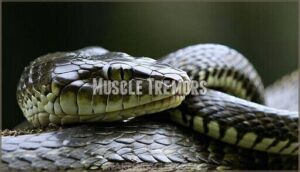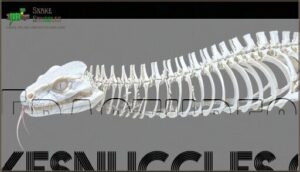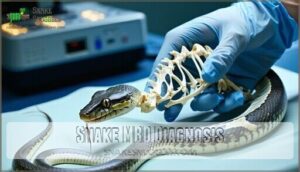This site is supported by our readers. We may earn a commission, at no cost to you, if you purchase through links.

You’ll notice soft, bendy bones, muscle tremors, and difficulty moving. Poor diet and lack of UVB lighting are the main culprits.
Your snake might lose weight, become lethargic, or suffer fractures from weakened bones. Fast-growing juveniles and breeding females face the highest risk.
Early detection is vital since advanced cases can cause permanent deformities. Treatment involves dietary changes, calcium supplements, and proper UVB lighting.
The good news? It’s completely preventable with the right setup and feeding routine.
Table Of Contents
- Key Takeaways
- Snake MBD Symptoms
- Causes of Snake MBD
- Snake MBD Diagnosis
- Treating Snake MBD
- Preventing Snake MBD
- Frequently Asked Questions (FAQs)
- What are the symptoms of metabolic bone disease in snakes?
- What is a metabolic disease in snakes?
- Which snake species are most susceptible to MBD?
- How long does MBD treatment typically take?
- Can MBD be completely reversed once diagnosed?
- What are the long-term complications of untreated MBD?
- Are there any genetic factors that increase MBD risk?
- Conclusion
Key Takeaways
- You can prevent snake MBD entirely by providing proper nutrition, adequate UVB lighting, and appropriate calcium supplementation – prevention is far easier than treatment
- Early detection is crucial because advanced cases cause permanent bone deformities, while mild cases caught early can be completely reversed with proper care
- Poor husbandry practices are the main culprit – inadequate UVB lighting, calcium deficiency, and improper diet create the perfect storm for this serious condition
- Juvenile snakes and breeding females face the highest risk due to their increased calcium demands during rapid growth and egg production periods
Snake MBD Symptoms
When your snake develops metabolic bone disease, you’ll notice several distinct physical changes that signal serious health problems.
These symptoms range from visible bone deformities to neurological issues that can become life-threatening without proper treatment.
Bone Abnormalities
Snake bone abnormalities represent the most visible signs of metabolic bone disease, creating skeletal deformities that fundamentally alter your snake’s structure.
You’ll notice these changes as the disease progresses, affecting everything from spinal alignment to jaw function.
- Spinal deformities – kinks, curves, and scoliosis that create abnormal body positioning
- Jaw recession – soft, pliable lower jaw that interferes with feeding ability
- Pathologic fractures – spontaneous bone breaks without obvious trauma or injury
These snake bone problems develop as calcium deficiency weakens the skeletal framework, making bones susceptible to damage and deformation.
This deficiency can lead to a condition known as nutritional secondary hyperparathyroidism.
Muscle Tremors
You’ll notice muscle tremors starting as subtle twitches that worsen with advanced MBD progression.
Tremors signal your snake’s bones are stealing calcium from muscles to survive.
These involuntary movements signal severe neurological impact from calcium deficiency, disrupting your snake’s electrolyte balance, and movement impairment becomes obvious as tremor severity increases, affecting your pet’s ability to control basic functions.
Snake MBD creates metabolic bone disease complications that compromise reptile health through disrupted muscle coordination and nerve function, leading to severe neurological impact from calcium deficiency.
Weight Loss
MBD-related appetite loss becomes a devastating spiral, where your snake’s inability to eat properly accelerates the disease’s progression.
This anorexia causes muscle atrophy and malnutrition impact, creating digestive issues that worsen feeding difficulties and overall health decline.
Anorexia and lethargy are common indicators of illness, so monitoring your snake is essential.
- Your snake’s jaw becomes too weak to grasp prey effectively
- Muscle weakness prevents proper constriction and swallowing mechanisms
- Digestive system dysfunction reduces nutrient absorption from consumed food
- Severe deformities make positioning for feeding nearly impossible
- Progressive weight loss creates a cycle where recovery becomes increasingly difficult
Lethargy
Beyond the physical symptoms, lethargy becomes a major concern when snake metabolic bone disease progresses.
You’ll notice your snake becoming increasingly sluggish, showing reduced activity levels and reluctance to move normally.
Recognizing lethargy early helps prevent severe complications.
Lethargy causes include calcium deficiency affecting muscle function and energy metabolism.
Treating lethargy requires addressing underlying nutritional imbalances through proper supplementation and husbandry corrections.
Fractures
Weak bones snap like twigs under your snake’s own weight, creating pathological fractures that signal advanced metabolic bone disease.
Your snake’s bones become fragile paper, breaking under the slightest pressure.
Your reptile’s calcium-deficient skeleton can’t handle normal movement, leading to these devastating breaks:
- Spinal compression fractures causing permanent deformity
- Rib fractures from gentle handling
- Limb breaks during routine activities
- Jaw fractures while feeding
These bone fractures require immediate veterinary attention for proper healing process and pain management interventions.
Causes of Snake MBD
Understanding what causes MBD in your snake helps you prevent this serious condition from developing.
Poor husbandry practices, dietary imbalances, and environmental deficiencies work together to create the perfect storm for metabolic bone disease.
Calcium Deficiency
Your snake’s bones need calcium like a car needs fuel.
When dietary calcium falls short, your pet’s body raids bone stores to maintain blood calcium levels, weakening the skeleton.
Poor calcium absorption from gut issues or inadequate calcium sources in food creates dangerous imbalances.
Calcium metabolism depends on proper ratios, making supplement overdose as harmful as deficiency.
Vitamin D Deficiency
When your snake lacks vitamin D3, calcium absorption becomes severely compromised, creating a domino effect throughout their skeletal system.
This UVB dependence means you’ll need to address three critical areas:
- D3 synthesis through proper UVB lighting exposure
- Dietary sources like fortified prey items
- Supplement dosage following veterinary guidance
Without adequate vitamin D3, your snake’s body can’t effectively utilize available calcium, regardless of dietary intake.
Dull eyes and poor shedding can also indicate snake nutritional deficiencies.
Phosphorus Imbalance
Too much phosphorus throws off your snake’s calcium to phosphorus ratio, creating hyperphosphatemia that interferes with calcium absorption.
This phosphorus imbalance triggers phosphorus retention and mineral interference, leading to organ damage from phosphorus toxicity.
Common dietary sources like muscle meat worsen the calciumphosphorus ratio, while poor excretion mechanisms compound the problem, ultimately causing bone demineralization.
Snakes are generally exempt from this condition because they consume whole prey, which addresses the need for adequate dietary calcium and D3.
Improper Diet
Your snake’s dietary choices can make or break its bone health, turning proper nutrition into a life-or-death decision.
Poor feeding practices create snake calcium deficiency through inadequate reptile nutrition and disrupted calcium to phosphorus ratio.
Common dietary mistakes include:
- Insects Only – Lacks essential minerals for proper calcium absorption
- Organ Meats – Missing bone content that provides calciumrich foods
- Limited Food Variety – Prevents balanced snake diet through gut loading
Inadequate UVB Lighting
Your snake’s body can’t manufacture vitamin D3 without proper UVB wavelengths, creating a domino effect that leads to snake calcium deficiency and snake vitamin D deficiency.
Without adequate reptile UVB lighting, your pet’s calcium to phosphorus ratio becomes imbalanced, disrupting normal basking behavior and preventing essential nutrient absorption that maintains healthy bones and prevents metabolic bone disease.
Proper lighting guarantees healthy reptile products are available.
Snake MBD Diagnosis
When you suspect your snake has MBD, a thorough diagnostic approach combines clinical examination with specialized testing to confirm the condition.
Your veterinarian will assess bone integrity through physical examination, X-rays, blood work, and a complete review of your husbandry practices, which includes evaluating bone integrity.
Physical Exam
During a physical exam, your reptile veterinarian will check for snake skeletal issues by gently palpating the body—looking for abnormal bends or swelling (Palpation Findings).
They’ll assess hydration, skin condition, and listen for odd Respiratory Sounds.
Neurological Signs like tremors or sluggishness are also noted.
A thorough physical exam helps spot metabolic bone disease early, so regular checkups with a snake vet matter, ensuring the overall health of your pet.
Radiographs
After your physical examination reveals potential concerns, radiographs provide the definitive imaging needed for accurate MBD diagnosis.
These X-rays reveal bone density changes, fracture identification, and vertebral abnormalities that aren’t visible during routine handling. Multiple views capture your snake’s entire skeletal structure, showing scoliosis detection and bone radiology details essential for treatment planning.
Recognizing signs of illness is vital for early intervention.
- Bone Density Assessment – Radiographs show osteopenia and cortical thinning characteristic of MBD
- Fracture Identification – Multiple pathologic fractures appear as folding or incomplete breaks
- Vertebral Abnormalities – Spinal deformities like scoliosis and kyphosis become clearly visible
- Soft Tissue Evaluation – Limited visualization of organs helps rule out other conditions
- Treatment Monitoring – Serial bone X-rays track healing progress and bone density improvements
Blood Calcium Tests
Blood work reveals calcium levels that help your veterinarian assess metabolic bone disease severity.
Interpreting results requires understanding calcium homeostasis and phosphorus correlation, as reptile calcium imbalance affects overall calcium metabolism.
Test accuracy depends on proper sample handling, while monitoring treatment progress through repeated calcium deficiency screenings confirms your snake’s recovery stays on track.
Husbandry Evaluation
Your veterinarian’s detective work begins with examining your snake’s entire living situation.
Enclosure size, thermal gradient, humidity levels, substrate type, and hygiene practices all play vital roles in preventing calcium deficiency and vitamin D problems.
Poor snake care and inadequate reptile husbandry often trigger snake health problems before symptoms appear.
Treating Snake MBD
When your snake shows signs of MBD, you’ll need to act quickly with a thorough treatment plan that addresses both the immediate symptoms and underlying causes.
Treatment success depends on catching the disease early and working closely with an exotic veterinarian to implement dietary changes, supplementation, and environmental improvements, which is crucial for treatment success.
Dietary Adjustments
Once your vet confirms the diagnosis, fixing your snake’s diet becomes the foundation of recovery.
You’ll need to swap problematic foods for calcium-rich options while controlling phosphorus levels. A balanced diet with proper vitamin supplementation helps restore mineral balance and supports bone healing.
The diet’s impact on electrolyte and fluid balance is vital for overall health.
- Calcium Sources: Offer whole prey items like appropriately-sized rodents, which provide natural calcium from bones rather than muscle meat alone
- Phosphorus Control: Eliminate high-phosphorus foods such as organ meats, fish, and unsupplemented insects that worsen calcium deficiency
- Vitamin Balance: Include vitamin D and calcium supplementation through dusting prey or liquid supplements to guarantee proper nutrient absorption
Calcium Supplementation
After diagnosing metabolic bone disease, you’ll need to restore your snake’s calcium levels through targeted supplementation.
Your veterinarian will determine the appropriate supplement types and dosage calculation based on your snake’s weight and severity of deficiency. Administration methods include oral calcium supplements mixed with food or injectable calcium for severe cases.
Many owners find it convenient to buy snake supplements online. However, over-supplementation risks include kidney damage and metabolic imbalances, so precise dosing is essential for safe calcium absorption and long-term effects on bone health.
Vitamin D Therapy
Vitamin D therapy bridges the gap between snake vitamin D deficiency and healthy calcium absorption. Your veterinarian will prescribe specific vitamin D3 supplementation based on your snake’s condition and species requirements.
- D3 Synthesis – Injectable or oral vitamin D3 helps restore proper calcium metabolism
- Dosage Guidelines – Follow veterinary recommendations for species-specific vitamin D supplementation amounts
- Toxicity Risks – Monitor for overdose symptoms like kidney damage or excessive calcium levels
- Therapy Duration – Treatment typically lasts several weeks to months depending on severity
- Monitoring Progress – Regular blood tests track vitamin D levels and calcium absorption improvement
UVB Light Therapy
UVB light therapy restores your snake’s ability to synthesize vitamin D, enabling proper calcium absorption.
Install full-spectrum UVB bulbs covering appropriate wavelengths for your species, maintaining 10-12 hour light duration cycles.
Replace bulbs every 6-8 months since UVB output diminishes over time.
Many owners purchase specialized reptile bulbs for their snakes.
Position lights to create a proper basking spot while ensuring light safety through appropriate distances and fixture guards.
Bone Stabilization
When severe metabolic bone disease causes fractures in your snake, bone stabilization becomes essential for recovery.
Your reptile veterinarian will assess fracture types and recommend appropriate splinting techniques or surgical options based on severity.
Key stabilization methods include:
- External splints – Lightweight casts for minor fractures
- Internal fixation – Pins or plates for complex breaks
- Pain management – Analgesics during healing process
- Post-op care – Restricted movement and monitoring
Preventing Snake MBD
You can prevent MBD in your snake by maintaining proper husbandry and nutrition from day one.
Prevention is far easier and more effective than treating this serious condition after it develops.
Balanced Diet
Prevention starts with feeding your snake a balanced reptile diet that maintains proper calcium and phosphorus ratios.
You’ll need to establish consistent calcium sources while managing phosphorus intake through strategic prey selection and supplement schedules.
| Food Category | Calcium Sources | Phosphorus Ratio |
|---|---|---|
| Primary Prey | Whole rodents, chicks | 1.5:1 to 2:1 ideal |
| Supplements | Calcium powder, Vitamin D3 | Dust prey weekly |
| Gut Loading | Calcium-rich vegetables | 24-48 hours before feeding |
Gut loading feeder insects with calcium-rich foods improves nutritional value.
Your supplement schedule should include calcium powder dusting and vitamin D3 supplementation twice monthly.
Whole prey animals naturally provide better calcium-to-phosphorus ratios than processed foods, supporting healthy bone development and preventing metabolic bone disease.
Proper Husbandry
Beyond feeding your snake the right foods, creating the perfect home environment prevents metabolic bone disease from taking hold.
Thermal gradients let your snake regulate body temperature for proper digestion, while adequate enclosure size provides room for natural movement.
Water access supports hydration, multiple hide availability reduces stress, and appropriate substrate choice prevents injuries.
These husbandry basics work together to keep reptile bone disease at bay, ensuring a healthy environment through proper digestion.
Regular Health Checks
Regular health checks serve as your early warning system against metabolic bone disease and other snake illnesses.
Schedule vet visits every six months, or sooner if you notice changes in shedding patterns, weight monitoring reveals losses, or hydration status seems off.
Early detection through consistent reptile health monitoring and reptile veterinary care prevents minor issues from becoming serious reptile symptoms requiring intensive treatment.
Adequate UVB Lighting
UVB lighting serves as your snake’s indoor sun, enabling essential vitamin D synthesis for calcium metabolism and preventing metabolic bone disease.
Install species-appropriate UVB bulbs with proper UVB intensity, maintain 10-12 hour lighting duration cycles.
Replace bulbs every 6-12 months since ultraviolet light output degrades over time, even when visible light remains bright, to ensure proper UVB intensity.
Calcium and Vitamin D Supplementation
Your snake’s calcium and vitamin D supplementation schedule acts as insurance against metabolic bone disease.
Dust prey with calcium powder weekly, adding vitamin D3 monthly for indoor snakes.
Monitor supplement dosage carefully—over-supplementation causes toxicity.
Administration methods include dusting food or gut-loading prey.
Watch for supplement interactions with medications.
Track your snake’s bone health through regular vet checkups to assess long-term effects of your reptile treatment program.
Frequently Asked Questions (FAQs)
What are the symptoms of metabolic bone disease in snakes?
Your snake’s bones could literally turn to rubber! You’ll notice devastating spinal deformities, pathological fractures, muscle tremors, lethargy, and difficulty moving. Advanced cases show paralysis and seizures.
What is a metabolic disease in snakes?
Metabolic bone disease is a serious condition you’ll encounter when your snake’s bones weaken and soften due to calcium deficiency, improper nutrition, and inadequate UVB lighting exposure.
Which snake species are most susceptible to MBD?
Young, rapidly growing snakes like ball pythons and corn snakes face higher MBD risk due to their calcium demands.
Female snakes during egg production also show increased susceptibility to this bone-weakening condition.
How long does MBD treatment typically take?
Ironically, patience becomes your greatest asset when treating this impatient condition.
MBD treatment typically takes 3-6 months with proper diet, UVB lighting, and calcium supplementation, though severe cases may require longer recovery periods.
Can MBD be completely reversed once diagnosed?
MBD reversal depends on early detection and severity. You can reverse mild cases with proper diet, UVB lighting, and supplements, but severe bone deformities remain permanent.
What are the long-term complications of untreated MBD?
Untreated cases lead to permanent bone deformities, chronic pain, pathologic fractures, spinal curvature, paralysis, seizures, and potentially death in severe situations.
Are there any genetic factors that increase MBD risk?
In the case of the cards you’re dealt, genetics doesn’t stack the deck against your reptile.
Current research doesn’t identify specific genetic factors that increase MBD risk in snakes, though some species show higher susceptibility due to their natural calcium requirements.
Conclusion
Snake metabolic bone disease threatens your reptile’s health when calcium, phosphorus, and vitamin D3 levels drop dangerously low.
Prevention remains your most powerful tool against this debilitating condition. You’ll protect your snake by providing proper nutrition, adequate UVB lighting, and appropriate calcium supplementation.
Regular veterinary checkups help catch early warning signs before permanent damage occurs. Remember that juvenile snakes and breeding females need extra attention due to their higher nutritional demands.
With consistent care and proper husbandry practices, you can completely prevent snake metabolic bone disease from affecting your pet, and this is a result of taking the right preventive measures.
- https://www.merckvetmanual.com/exotic-and-laboratory-animals/reptiles/metabolic-and-endocrine-diseases-of-reptiles
- https://azeah.com/reptiles-amphibians-lizards-tortoises-turtles/nutritional-secondary-hyperparathyroidism-metabolic
- https://www.thesprucepets.com/metabolic-bone-disease-in-reptiles-1237237
- https://www.vetlexicon.com/exotis/reptiles/musculoskeletal/articles/metabolic-bone-disease/
- https://www.petplace.com/article/reptiles/general/metabolic-bone-disease-in-reptiles



















